7.4 /10 1 Votes
6.5/10 TV First episode date 30 September 1959 | 8.2/10 IMDb Also known as Space Challenge Final episode date 14 September 1960 | |||||||||||||||||||||||||||||||||
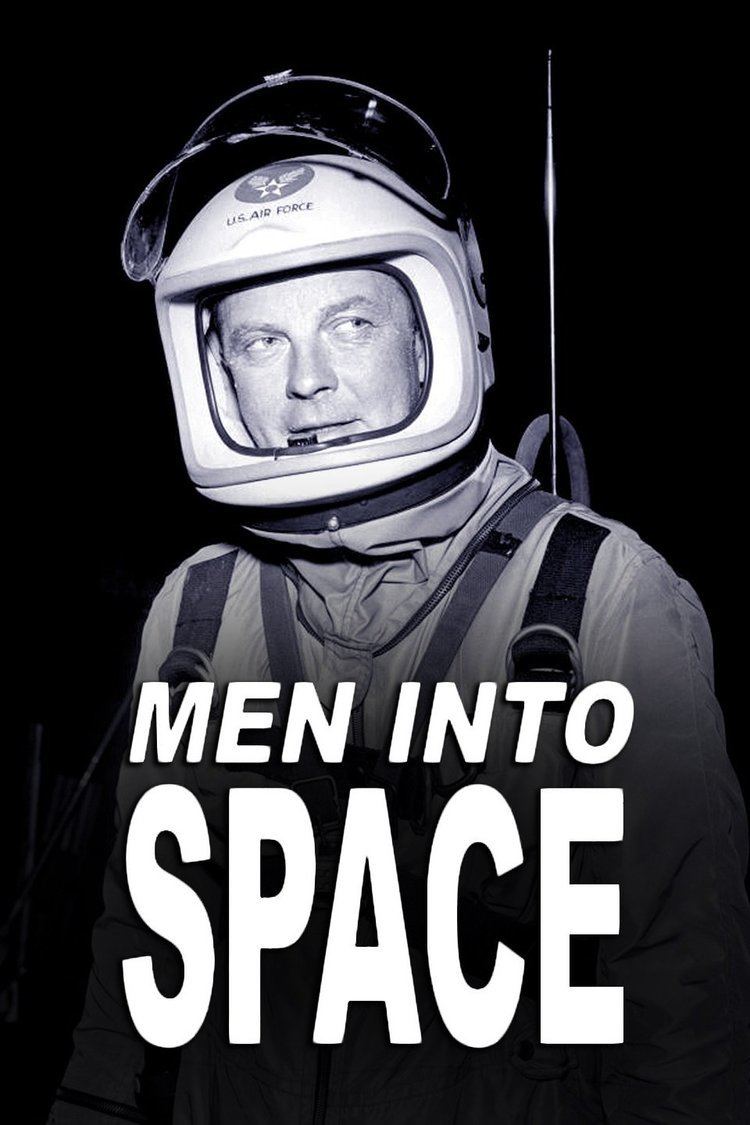 | ||||||||||||||||||||||||||||||||||
Written by Jerome BixbyStuart J. ByrneJames ClavellMeyer DolinskyDavid DuncanSidney KalcheimRobert Warnes LeachIb MelchiorMarianne MosnerMichael PlantFrancis RosenwaldWilliam TempletonArthur Weiss Directed by William ConradAlan Crosland, Jr.Walter DonigerAlvin GanzerJack HerzbergHerman HoffmanNathan H. JuranOtto LangLee SholemHerbert L. Strock Starring William LundiganTyler McVey Cast | ||||||||||||||||||||||||||||||||||
Men Into Space (a.k.a. Space Challenge in later syndication) is an American black-and-white science fiction television series, produced by Ziv Television Programs, Inc., that was first broadcast from September 30, 1959 to September 7, 1960 by CBS. The syndicated series depicts future efforts by the United States Air Force to explore and develop outer space. The series' star, William Lundigan, played Col. Edward McCauley.
Contents
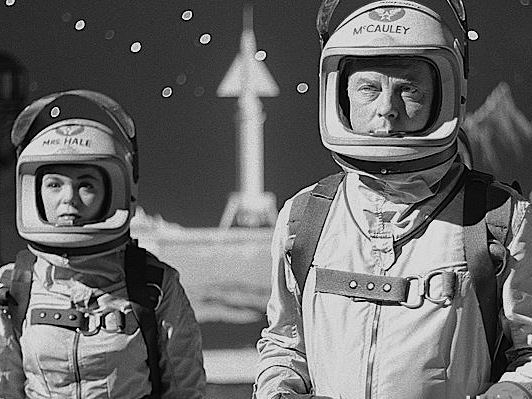
Scenarios
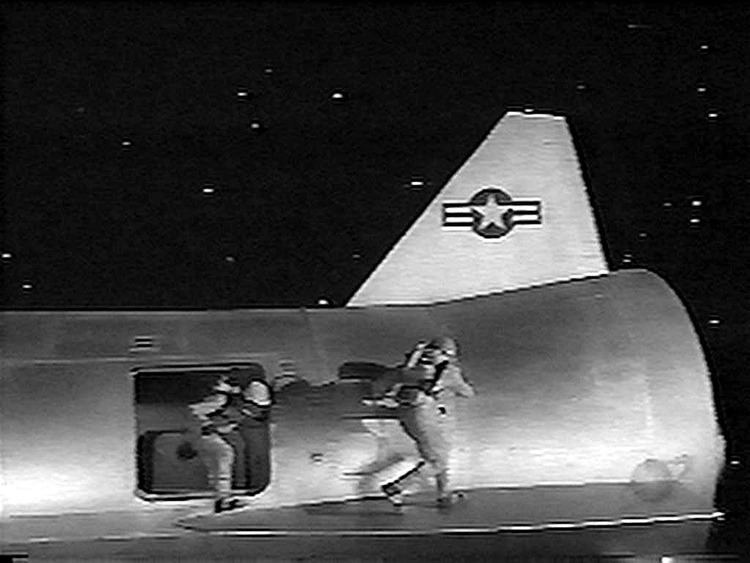
Men Into Space was not set in a specified era, but clues dropped in the scripts indicated that it took place between the mid-1970s and mid-1980s, with the first Moon landing happening somewhere around 1975. Props were occasionally futuristic (such as a forerunner of today's real-life LCD TVs), but the show's Earthly clothing and environs, including automobiles, telephones, and other machines, were decidedly 1950s. The program aired in the year just prior to the beginning of manned spaceflight, with Vostok I and the Mercury program launching manned spacecraft in 1961.
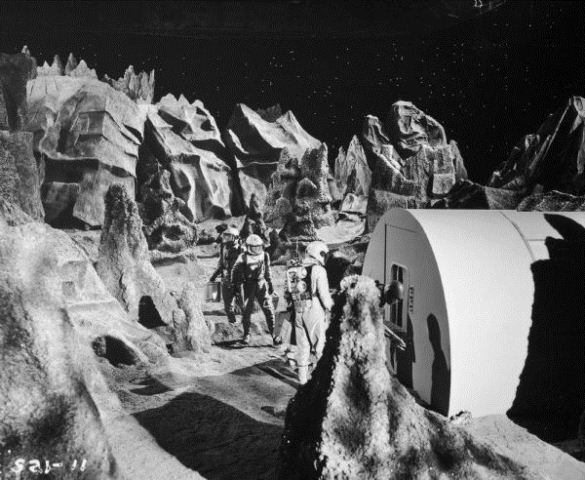
Men Into Space was somewhat unusual for a TV action series in that it had numerous recurring characters, but only one protagonist, Col. Edward McCauley (William Lundigan), who was in all of the 38 series' episodes. Tyler McVey appeared in seven episodes as Major General Norgath. Ron Foster appeared five times as Lieutenant Neil Templeton. Joyce Taylor had a recurring role in eight episodes as Col. McCauley's wife, Mary McCauley.
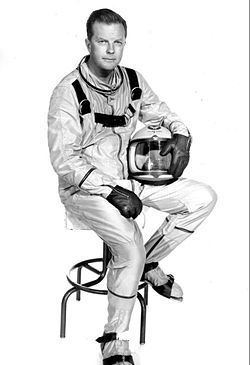
McCauley was a sort of "everyman" character who was viewed in the show as the most experienced and illustrious astronaut. As depicted in the scripts, the low-key but decisive McCauley was ubiquitous, assigned to every important space mission over at least a decade, including the earliest manned flights, the first flight to the Moon, many additional lunar landings and Moon base construction missions, construction of a space station, and two flights to Mars (neither succeeded, and folklore has it that plans for a never-aired second season would have focused on further missions to Mars and beyond).
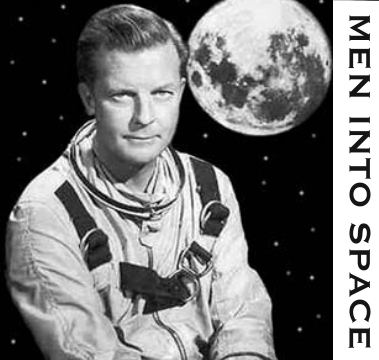
In many episodes the astronauts were faced with accidents or technical problems that required innovation. The program was not idealistic; missions sometimes failed and astronauts sometimes died. For example, a scientist-astronaut stricken with a coronary thrombosis while exploring the Moon was not expected to survive the G-forces of the return flight, so his comrades stowed the space-suited patient in a steel drum filled with water, to cushion him during launch. A "Space Race" episode involved spacecraft from the USA and the USSR starting out almost simultaneously on the first Mars mission, with the American spacecraft aborting its effort in order to rescue the Soviet crew after their spacecraft experienced problems.
The series included an episode whose plot essentially paralleled the ill-fated Apollo 13 mission's explosion in space more than a decade later and another that was an uncanny foretelling of the accident that befell the real Gemini VIII mission in 1966.
Scripts often considered the human factor, and while action was the show's forte, humor and romance were part of the mix. Men Into Space predicted women astronauts and scientists and married couples in space.
Accuracy
Men Into Space was advertised as being (for its era) an extremely accurate preview of manned spaceflight, based on scientific studies and buttressed by technical assistance from the USAF's ballistic missile and space medicine offices. The spacecraft designs, however, veered inconsistently between early 1950s Wernher Von Braun concept vehicles, and later, totally scaled-down spacecraft proposals. Visual backdrops and conceptual designs of spacecraft, space stations, and a Moon base depended somewhat on contributions from notable astronautics and science fiction artist Chesley Bonestell. The series also availed itself of extensive documentary footage of early missile launches, notably the Atlas missile. It evoked the earlier Disney space exploration documentaries, which in turn owed their look and feel to a widely read, early 1950s series on the subject in the old Collier's Weekly magazine, where Bonestell's art also held sway. At one point in production, a scale model and poster of an Atlas derived design missile with the series spacecraft as the payload was built, with publicity photos of Lundigen holding the model in front of the large poster. Several scenes used footage from the cancelled Navajo missile program to depict spacecraft landings on a desert runway. The distinctive design of the X-10 Navajo (different from the close up depictions of the series spacecraft) can be seen in the desert landing sequences X-10 Navajo missile.
Prediction of today's technologies
Men Into Space used for its plots many technical and human problems anticipated by engineers and planners. For example, the show depicted attempts to refuel spacecraft by tanker in orbit, construction of a space telescope, an experiment to dispose of high level atomic waste by launching it into the Sun, the search for life-sustaining frozen water on the Moon, and exploration and destruction of an asteroid whose orbit threatened Earth.
In two different episodes, the series even speculated about exo-fossil extraterrestrial life discovered while exploring a distant asteroid and about ancient Earth-orbiting spaceship debris belonging to a non-human, space-faring civilization.
Although the series was modestly budgeted, it was cleverly mounted with what, for its era, were good special effects helmed by Louis DeWitt. Even decades later, the series can still be appreciated for its attention to detail and accurate physics.
Scientific accuracy
A narrator explained in nearly every episode why the astronauts needed magnetic boots to walk in or upon their free-falling spacecraft, how a jet thruster backpack could propel an astronaut through the vacuum of space, why a wrong angle of attack could doom a spacecraft upon atmospheric re-entry, and so forth. The spacecraft in the program were shown gliding to a powerless landing on a dry lake bed, just like the real Space Shuttle nearly 25 years later. Footage of these landings used documentary film of the X-10 Navaho cruise missile landing at Edwards AFB.
On the other hand, dramatic license held sway on the episode soundtracks, which repeatedly depicted sound in the airless vacuum of space: airlocks hummed, rockets roared, explosions boomed, and footsteps on the Moon's surface could be heard. Dramatic license was also used when depicting the spacesuits being worn by the actors. They did not inflate when exposed to the vacuum of space, as they would later during actual space walks.
